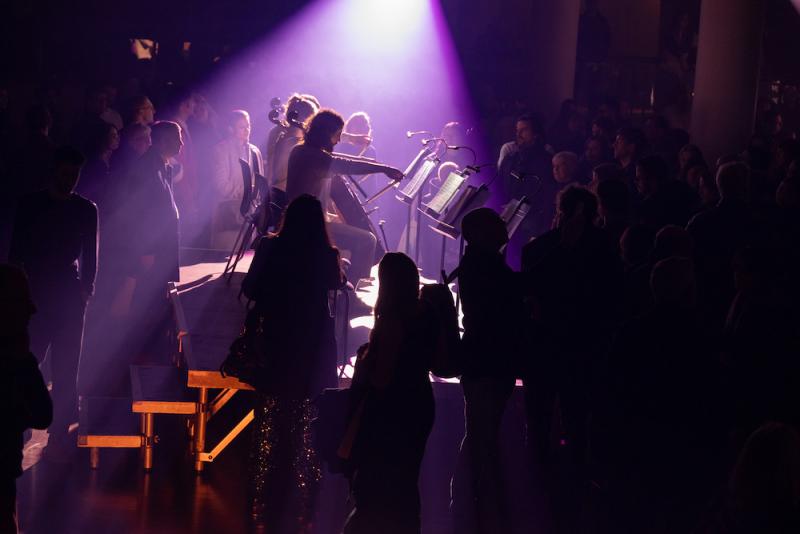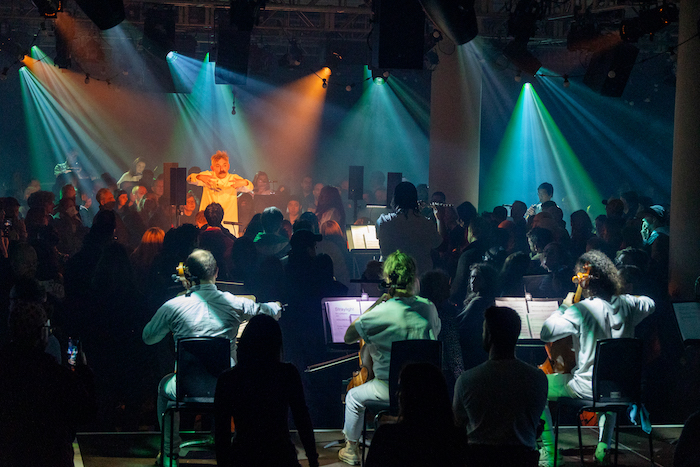Paraorchestra, Hazlewood, Southbank Centre review - re-thinking the orchestral experience | reviews, news & interviews
Paraorchestra, Hazlewood, Southbank Centre review - re-thinking the orchestral experience
Paraorchestra, Hazlewood, Southbank Centre review - re-thinking the orchestral experience
Hearing the orchestra from the inside offers new sounds and perspectives

The Clore Ballroom at the Southbank Centre is usually an open-plan space within the foyer, a little ambiguous in its extent and purpose. Last night, for the first time, I saw it enclosed and separated off, ambiently lit and full of smoke, for the Paraorchestra to evoke a 1970s New York loft happening, only with iPhones and the smoke coming from machines and not the audience’s wacky-baccy.
The music was inspired by the drones of 1970s minimalism and performed by a mixture of disabled and able-bodied professional instrumentalists, all dressed in white, led by their ringmaster Charles Hazlewood. It was a visually superb piece of theatre, and a musically intriguing and moving demonstration of the power of the drone.
Hazlewood gave an impressive and heartfelt spoken introduction, his peppy enthusiasm belying the lugubriousness of his young Einstein walrus moustache. He encouraged us to walk about the space in which the players were scattered on raised platforms, to “indulge your curiosity” in an environment in which normal concert rules didn’t apply. He also spoke of the appeal of drone music – what LaMonte Young called “the eternal now” – in its denial of “goal-orientation”, the essential drive of most western classical music. Instead, starting with Rylan Gleave’s new work Straylight, we were into a world of sustained sounds, over which instrumental swells came and went. There was a strongly electronic element giving the sounds a complex, knotty quality. I went and stood by the striking Ross Hughes, bald, bearded, bespectacled and in a lab coat, giving off strong mad-scientist vibes as he twisted his various controllers, fat noises bursting from his amp. Over his shoulder I could see the sections had titles like “stoned, drifting” and “maniacal, itching” and as these came and went, I reflected that drone music isn’t by any means music in which nothing happens.
Instead, starting with Rylan Gleave’s new work Straylight, we were into a world of sustained sounds, over which instrumental swells came and went. There was a strongly electronic element giving the sounds a complex, knotty quality. I went and stood by the striking Ross Hughes, bald, bearded, bespectacled and in a lab coat, giving off strong mad-scientist vibes as he twisted his various controllers, fat noises bursting from his amp. Over his shoulder I could see the sections had titles like “stoned, drifting” and “maniacal, itching” and as these came and went, I reflected that drone music isn’t by any means music in which nothing happens.
As I walked around the space – which people were for the most part doing – the sound changed fascinatingly, whether from the periphery, where the whole picture came over, or near individual players, where their notes and lines emerged. It was, as Hazlewood had promised, a chance to be “inside looking out”, the opposite of a “normal” orchestral performance. The only complaint, if complaint is the right word, is that there were slightly too many people there to make the moving around entirely smooth. But I am certainly not going to bemoan the Paraorchestra being so popular, which is rather something to be celebrated. There was a change of pace for the second piece, Arvo Pärt’s Fratres, for which the electronics fell silent, and 12 string players, in groups of three, played a delicate, circling chorale. Behind its quiet chords you could hear the bustle of the Festival Hall bar, emphasising the fragility of the music, and Hazlewood, conducting from the middle, had the poise and elegance of a dancer filmed in slo-mo.
There was a change of pace for the second piece, Arvo Pärt’s Fratres, for which the electronics fell silent, and 12 string players, in groups of three, played a delicate, circling chorale. Behind its quiet chords you could hear the bustle of the Festival Hall bar, emphasising the fragility of the music, and Hazlewood, conducting from the middle, had the poise and elegance of a dancer filmed in slo-mo.
The final piece, Pauline Oliveros’ The Last Time, an electronic work “realised” for live players by Charlotte Harding, was captivating. The synths were back, and the swelling instrumental chords (I was next to the horn player for a while) all provided a bed for the extraordinary vocals of Victoria Oruwari. Her vocalise went from a straight tone to being passed through a range of filters, exploring the gamut of sounds a voice and a sound desk together can produce. It was hypnotic and transporting, reminding me a bit of Pink Floyd’s “The Great Gig in the Sky”, and I wish it had gone on longer, not something you always feel after exposure to minimalism.
rating
Share this article
The future of Arts Journalism
You can stop theartsdesk.com closing!
We urgently need financing to survive. Our fundraising drive has thus far raised £49,000 but we need to reach £100,000 or we will be forced to close. Please contribute here: https://gofund.me/c3f6033d
And if you can forward this information to anyone who might assist, we’d be grateful.

Subscribe to theartsdesk.com
Thank you for continuing to read our work on theartsdesk.com. For unlimited access to every article in its entirety, including our archive of more than 15,000 pieces, we're asking for £5 per month or £40 per year. We feel it's a very good deal, and hope you do too.
To take a subscription now simply click here.
And if you're looking for that extra gift for a friend or family member, why not treat them to a theartsdesk.com gift subscription?
more Classical music
 Kilsby, Parkes, Sinfonia of London, Wilson, Barbican review - string things zing and sing in expert hands
British masterpieces for strings plus other-worldly tenor and horn - and a muscular rarity
Kilsby, Parkes, Sinfonia of London, Wilson, Barbican review - string things zing and sing in expert hands
British masterpieces for strings plus other-worldly tenor and horn - and a muscular rarity
 From Historical to Hip-Hop, Classically Black Music Festival, Kings Place review - a cluster of impressive stars for the future
From quasi-Mozartian elegance to the gritty humour of a kitchen inspection
From Historical to Hip-Hop, Classically Black Music Festival, Kings Place review - a cluster of impressive stars for the future
From quasi-Mozartian elegance to the gritty humour of a kitchen inspection
 Shibe, LSO, Adès, Barbican review - gaudy and glorious new music alongside serene Sibelius
Adès’s passion makes persuasive case for the music he loves, both new and old
Shibe, LSO, Adès, Barbican review - gaudy and glorious new music alongside serene Sibelius
Adès’s passion makes persuasive case for the music he loves, both new and old
 Anja Mittermüller, Richard Fu, Wigmore Hall review - a glorious hall debut
The Austrian mezzo shines - at the age of 22
Anja Mittermüller, Richard Fu, Wigmore Hall review - a glorious hall debut
The Austrian mezzo shines - at the age of 22
 First Person: clarinettist Oliver Pashley on the new horizons of The Hermes Experiment's latest album
Compositions by members of this unusual quartet feature for the first time
First Person: clarinettist Oliver Pashley on the new horizons of The Hermes Experiment's latest album
Compositions by members of this unusual quartet feature for the first time
 Gesualdo Passione, Les Arts Florissants, Amala Dior Company, Barbican review - inspired collaboration excavates the music's humanity
At times it was like watching an anarchic religious procession
Gesualdo Passione, Les Arts Florissants, Amala Dior Company, Barbican review - inspired collaboration excavates the music's humanity
At times it was like watching an anarchic religious procession
 Classical CDs: Camels, concrete and cabaret
An influential American composer's 90th birthday box, plus British piano concertos and a father-and-son duo
Classical CDs: Camels, concrete and cabaret
An influential American composer's 90th birthday box, plus British piano concertos and a father-and-son duo
 Cockerham, Manchester Camerata, Sheen, Martin Harris Centre, Manchester review - re-enacting the dawn of modernism
Two UK premieres added to three miniatures from a seminal event of January 1914
Cockerham, Manchester Camerata, Sheen, Martin Harris Centre, Manchester review - re-enacting the dawn of modernism
Two UK premieres added to three miniatures from a seminal event of January 1914
 Kempf, Brno Philharmonic, Davies, Bridgewater Hall, Manchester review - European tradition meets American jazz
Bouncing Czechs enjoy their Gershwin and Brubeck alongside Janáček and Dvořák
Kempf, Brno Philharmonic, Davies, Bridgewater Hall, Manchester review - European tradition meets American jazz
Bouncing Czechs enjoy their Gershwin and Brubeck alongside Janáček and Dvořák
 Solomon, OAE, Butt, QEH review - daft Biblical whitewashing with great choruses
Even a top soprano and mezzo can’t make this Handel paean wholly convincing
Solomon, OAE, Butt, QEH review - daft Biblical whitewashing with great choruses
Even a top soprano and mezzo can’t make this Handel paean wholly convincing
 Two-Piano Gala, Kings Place review - shining constellations
London Piano Festival curators and illustrious friends entertain and enlighten
Two-Piano Gala, Kings Place review - shining constellations
London Piano Festival curators and illustrious friends entertain and enlighten
 Echo Vocal Ensemble, Latto, Union Chapel review - eclectic choral programme garlanded with dance
Beautiful singing at the heart of an imaginative and stylistically varied concert
Echo Vocal Ensemble, Latto, Union Chapel review - eclectic choral programme garlanded with dance
Beautiful singing at the heart of an imaginative and stylistically varied concert

Add comment